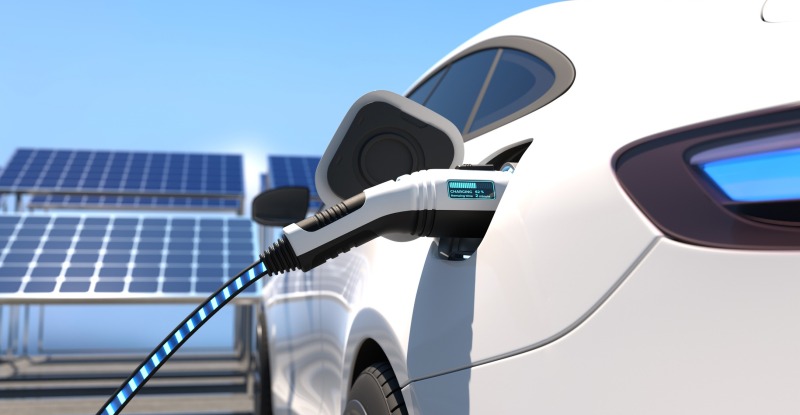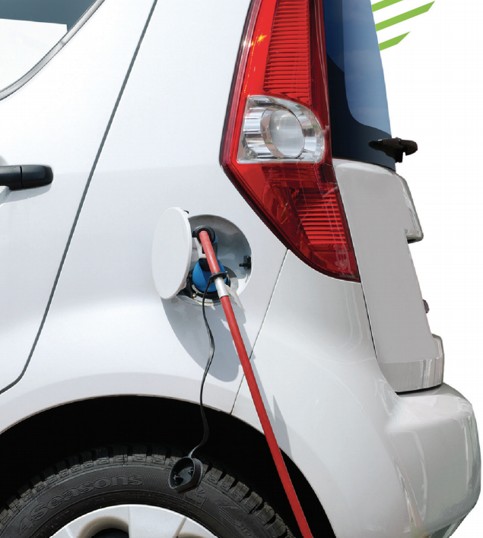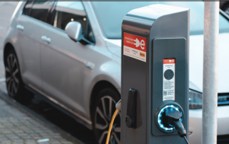
Think about the following questions.
1. Do you know anyone who has an electric car, a hybrid, or any other type of alternative-fuel vehicle?
2. Do you do anything in your daily life to reduce your personal environmental impact?
3. Some people think electric cars are unattractive. Do you agree or disagree?
VOCABULARY PREVIEW
Match each New Academic Word List(NAWL) word with the correct definition.
- destination
- instability _____
- dioxide _____
- finite _____
- essentially _____
- ion _____
- a. the place to which someone or something is going or being sent
- b. the state of being likely to change
- c. an atom or molecule with a positive or negative charge
- d. having a limit
- e. in the most basic or general way
- f. any chemical compound that includes a molecule with two oxygen atoms
THE SPARK OF A NEW ERA

Besides the obvious environmental concerns, consumers and policymakers now have plenty of reasons to consider alternatives to the gasoline engine. Although there is no consensus on how much oil there is left, as a non-renewable resource, it is finite by definition. In terms of geopolitics, oil is often a cause of instability. Many oil-rich countries have used that advantage in ways the rest of the world resents. These dynamics1 have shifted an increasing amount of attention to alternatives, especially hybrids and fully electric cars.
Environmental issues remain the most compelling2 reasons to explore electric alternatives. In the US, for example, automobiles account for a fifth of total human carbon dioxide (CO2) emissions, which have been identified as a major cause of global warming. Car exhaust also contributes to the growing problem of urban air pollution. Nitrogen dioxide gas (NO2) is a toxic3 byproduct of diesel fuel combustion. This gas is rising above safe levels in urban areas all over the world.
Electric technologies are cleaner across the board. It is important to note that electric cars still get their power from the grid4, so they run on whatever the closest power plant does. The majority of these plants burn fossil fuels, including coal, which is hands down the biggest producer of CO2 and other pollutants. Nevertheless, electric cars still come out ahead. Even if they use one hundred percent coal-powered electricity, they create twenty-five percent less atmospheric pollution than their fossil-fuel counterparts.
Electric options also have several economic advantages. The first is fuel costs: roughly $30 per month for electricity versus $100 for gas. And fully electric cars, in particular, require less engine maintenance and retain higher resale values than gasoline cars in the same classes. Until very recently, the sticker price of the electric car was the biggest disadvantage-most started at around $40,000. But tax incentives and a new generation of more affordable options mean that electric cars are now within reach for the middle class. In the US, the BMW Mini Electric is the cheapest fully electric car on the market. As of 2021, this two-door compact was listed at $29,900. After tax rebates5, the real price could be as low as $22,400.
Yet electric technology is not without its downsides. To date, the biggest problem is still plugging in, since electric car owners need to be aware of the locations of electric charging stations and plan their destinations accordingly. Charging also takes quite a lot longer than filling a gas tank-between four and eight hours for most models. And the range6 of electric cars still averages only about 250 miles on a full charge. Gas cars vary more widely but average between 400 and 500 miles. Having to stop every couple of hundred miles to charge for hours makes electric cars impractical for long road trips. Electric cars also lag behind7 in performance. Top speeds tend to be slower, and the lighter materials often mean the cars are harder to handle. Further, while electric cars need maintenance less often, repairs are generally more expensive. This can include replacement of the car's lithium-ion battery, which can cost from $5,000 to $16,000.
But teams at automakers, research universities, and government agencies are not content to stop there. Many proposed improvements utilize nanomaterials8 to pack more power into a smaller package-essentially to do for the electric car what silicon did for the personal computer. Some experts expect ranges of 500 miles to be commonplace9 within a decade. For most commentators, the pros will unquestionably outweigh the cons at that point.
New Academic Word List
- dynamic 1 : n. the way that two or more people or things behave with each other because of a particular situation
- compelling 2 : adj. strong and forceful
- toxic 3 : adj. poisonous
- grid 4 : n. a network of wires and equipment that supplies electricity to a large area
- rebate 5 : n. an amount of money that a consumer receives back for buying a particular product or service
- range 6 : n. the distance over which a vehicle can travel before it needs more fuel
- lag behind 7 : v. to be in a position that is behind others; to develop more slowly
- nanomaterials 8 : n. materials of which a single unit is between 1 and 1,000 nanometers in size
- commonplace 9 : adj. very common or ordinary
READING COMPREHENSION
A ‣ Mark each statement as true (T) or false (F) according to the reading.
- Advocates of electric cars are mostly environmentalists.
- True
- False
- Electric cars powered by coal plants do not reduce air pollution.
- True
- False
- Electric cars don't need as much engine maintenance as gas-powered cars.
- True
- False
- Electric cars now perform better than their gasoline counterparts.
- True
- False
- Battery development is key to the future of electric technology.
- True
- False
B ‣ Choose the best answer according to the reading.
- What is the reading mainly about?
- a. The pros and cons of electric cars
- b. The reasons we need electric cars
- c. The role electric cars play in politics
- d. The future engineering of electric cars
- The word combustion in paragraph 2 means _____.
- a. burning
- b. combining
- c. engineering
- d. transforming
- Which of the following is NOT mentioned as a financial advantage of electric cars?
- a. Maintenance costs
- b. Resale value
- c. Battery price
- d. Tax incentives
- What can be inferred from paragraph 6?
- a. Current electric car batteries will be outdated soon.
- b. Electric cars will soon put traditional car companies out of business.
- c. Electric cars will be computer-controlled and driverless in the future.
- d. Experts are not optimistic about the future of electric cars.
C ‣ The following terms are explained in the reading. Write definitions for them.
- _____: the percentage difference in pollutant production between gas and electric cars
- _____: the monthly cost of electricity for an electric car
- _____: the price of the cheapest fully electric car after rebates
SUMMARY
Fill in the blanks with the phrases in the box.
- charging stations
- fuel costs
- CO2 and NO2
- short range
- lithium-ion batteries
- smaller and more powerful
|
|
|
VOCABULARY PRACTICE
Fill in the blanks with the words in the box. Change the form if necessary.
- dioxide
- destination
- essentially
- ion
- finite
- instability
- This flight stops in London, but its final _____ is Paris.
- Newton proved that there is a(n) _____ amount of energy and matter in the universe.
- The first airplanes were _____ big, elaborate kites with engines and propellers.
- Silicon _____ is little-known, but it is the most plentiful compound in its class.
- During times of economic _____ , many people prefer to keep their cash at home instead of in a bank.
- One type of chemical bond is formed when a positive _____ is joined to a negative one.
SUPPLEMENTAL READING
A Mass of Green

Using mass transit is often mentioned on lists of things people can do to reduce their environmental footprints. The reasoning is simple: twenty people on one bus use less fuel to go the same distance than they would in twenty cars. We should not, however, infer that public transportation is a perfect solution. Most buses still run on diesel fuel, a major polluter. And even electric subway systems draw power from power stations, which may be burning coal. By current estimates, public transportation accounts for as much as twenty-five percent of the world's energy usage and carbon emissions. This is why environmental scientists are searching for ways to make public transportation more environmentally sustainable.
One successful initiative has been the introduction of hybrid vehicles. Hybrids have both a standard fuel engine and an electric motor, which increases fuel efficiency. The advantages of hybrids over conventional buses, for instance, have been dramatic. New York City currently has the largest hybrid fleet in the world, which makes that city an interesting test case. One 2009 study found an increase in fuel efficiency of forty-five percent. And in a ten-year period, nitrogen oxide pollution was reduced by fifty-eight percent. Pollution from diesel particulates (soot) was reduced by an amazing ninety-seven percent.
Other major metropolitan areas have followed New York's lead. London is a good example. The city currently has a problem with air pollution, and in response, officials bought thirty-seven all- electric versions of those famous red double-decker buses.
Fill in the blanks with information from the reading.
- _____ , which powers most buses, is a major cause of pollution.
- Public transportation is responsible for about one-fourth of global carbon emissions and _____ .
- _____ are famous British vehicles that are making the change to electric technology.

Leave a comment
Load more